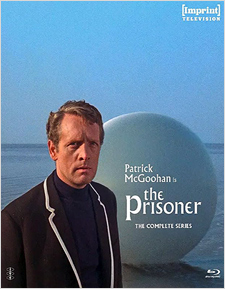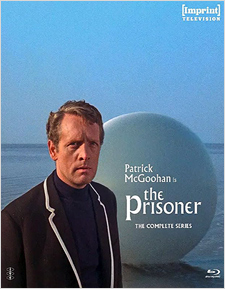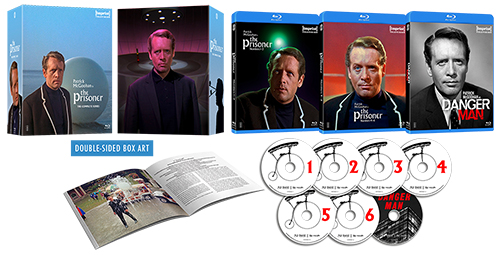Prisoner, The: The Complete Series (Blu-ray Review)

Director
VariousRelease Date(s)
1967-1968 (June 19, 2024)Studio(s)
Everyman Films/ITC Entertainment (Imprint Films/Via Vision Entertainment)- Film/Program Grade: A-
- Video Grade: A
- Audio Grade: A
- Extras Grade: A
Review
[Editor's Note: This is a Region-Free Australian Blu-ray import.]
For those unfamiliar, some important background: In 1960, Ralph Smart, a producer at ITC, the British television production company headed by Lew Grade, created a half-hour, black-and-white series called Danger Man. Patrick McGoohan, born in Queens, New York City to Irish immigrants but raised in Ireland and later in England, starred as a murkily-defined, globe-trotting secret agent. As his opening narration for each episode notes, “Every government has its secret service branch. America, CIA; France, Deuxième Bureau; England, MI5. NATO also has its own. A messy job? Well that’s when they usually call on me or someone like me. Oh yes, my name is Drake, John Drake.” Compact and adult, the series has the flavor of Ian Fleming’s 1950s James Bond novels; Fleming himself reportedly assisted in the program’s development, though departed early on. McGoohan, a devout Catholic, himself helped shape the show, insisting that Drake would not use firearms and he refused to do love scenes in accordance with his strict religious beliefs. It’s a terrific series but, regrettably, was a hard-sell to American television, seemingly the ultimate goal of every Lew Grade/ITC program. With no American financing for a second season (“series” in Britain) forthcoming, Danger Man was canceled after 39 episodes.
By 1964, however, the James Bond films Dr. No (1962) and From Russia with Love (1963) had been substantial hits, with the upcoming Goldfinger (1964) and the reissue of the first two features around the world igniting Bondmania and an entire new subgenre of jazzy spy films. In this environment, Smart revived Danger Man, this time as a black-and-white but one-hour program. Retitled Secret Agent for U.S. broadcast as a CBS summer replacement series (with Edwin Ashley’s title theme music replaced by Johnny Rivers’s hit song Secret Agent Man), the rebooted show was, this time, a big hit.
Though less compact than the half-hour version, at times shamelessly padded (a problem with virtually all hour-long ITC shows of that era), the revived Danger Man was inconsistent but often excellent, grounded in McGoohan’s tightly-wound, clipped-accented (somewhere between mid-Atlantic and English, with hints of Irish when agitated) performances; at times McGoohan was electrifying. At £2,000 a week he deservedly became one of the highest-paid TV stars in British television (though way less than Roger Moore’s $89,000/episode on the last seasons of The Saint. By way of comparison, at his peak William Shatner earned $6,000/episode for Star Trek).
After two seasons and 47 episodes, production on a third season—the first in color—began but by this point McGoohan had become disenchanted with the program, partly because of pressure from American financiers to make it “sexier” and he basically quit. And no wonder—the two episodes produced for season three up to that point, Koroshi and Shinda Shima, are positively terrible. (Both are set in Japan, and are as appallingly inauthentic as any movie or TV show supposedly set there, before or since.)
However, Lew Grade didn’t want the red-hot McGoohan to slip through his fingers, so when the actor pitched a concept for an alternative miniseries, he listened. With input from George Markstein (just how much has been debated for decades), McGoohan’s premise for The Prisoner is about a secret agent (McGoohan) who angrily resigns from the service for reasons unknown and is preparing to leave England (a passport is visible in the suitcase he’s seen packing) when he’s kidnapped from his London flat, awakening in “The Village,” a seaside community where ex-agents, diplomats, high-ranking military officials and others are effectively imprisoned, if in resort-like surroundings. No names are used, only numbers, and the former agent is assigned “No. 6.” In this Kafkaesque environment of endlessly cheery P/A announcements and soothing-grating music over radios hard to avoid, he finds himself under pressure to reveal the reason for his resignation. No. 6 repeatedly tries to outwit his captors, particularly No. 2 (played by a revolving door of different actors), and to escape from wherever it is he is. (Exteriors were filmed in the Baroque seaside community of Portmeirion, North Wales.)
Though never identified by name, No. 6 is clearly, absolutely John Drake from Danger Man/Secret Agent. Fans of the series have argued this point pro and con, but the obvious explanation is that McGoohan, who always insisted No. 6 wasn’t Drake, would have had to pay ITC producer Ralph Smart, the creator of the earlier shows, significant royalties had No. 6 explicitly been Drake. Amusingly, during the production of The Prisoner, McGoohan took time off the series (which suffered from his awkward absence) to appear in the big Cinerama thriller Ice Station Zebra (1968), again playing a secret agent, again John Drake in all but name.
Witty, allegorical, darkly humorous, suspenseful, perplexing and, occasionally, quite frustrating, The Prisoner was like no other program anywhere in the world in 1967, and still not quite like anything since. McGoohan wanted The Prisoner to run just seven episodes, but was persuaded to extend the show’s run to 17 episodes. The earlier shows are nearly brilliant while some of the later ones are rather thin and even pointless; one senses McGoohan losing interest as the series petered out, he ready to move on to something else. As with subsequent shows like The X-Files and Lost (to name two), he probably didn’t think his ingenious premise through. How would it end? What, if anything, would be resolved? What questions would be answered before it’s over? Those expecting answers in The Prisoner’s final episode probably will be disappointed. Nevertheless, the series made a huge impact; once seen it’s never forgotten.
I first stumbled upon the show in the mid-1970s, when from my Detroit suburb I caught reruns airing from across the Detroit River via a Windsor, Canada CBC affiliate. But I hadn’t seen it since A&E Home Video’s boxed DVD set from 2001. In 2009, A+E Networks released a Region “A” Blu-ray set, but Australia’s Imprint label goes all-out with extra features, including a 120-page booklet and five episodes of the two earlier Danger Man shows (two from the 1960s series, three from the 1964 revival), also in high-def and including extra features on those titles.
Shot on color 35mm film, the 1.37:1 2K restorations look outstanding, the 17 episodes generously spread across six Region_Free Blu-ray discs. Partly this is to accommodate all the extra features accompanying specific episodes, but in any case, each episode is extraordinarily clean with excellent color and contrast. Audio is offered in LPCM 2.0 mono and DTS-HD 5.1 remixes (the latter on episodes of The Prisoner only, not the Danger Man shows). While the 5.1 remixes aren’t original to the initial broadcasts they do add enormous oomph and are well-mixed. Also included are original music & effects tracks. In English only, optional English subtitles are provided. It all comes in sturdy hardbox packaging limited to 1,500 copies.
The extra features, much of it new, is practically endless. The fat booklet is loaded with great behind-the-scenes photos, an exhaustively researched making-of article by Andrew Pixley, material prepared by ITC to sell the show abroad, and an excellent episode guide with detailed credits.
Two feature-length documentaries are included: Don’t Knock Yourself Out, a 95-minute piece from 2007 about the making of the series, and In My Mind (2017), an 82-minute documentary about filmmaker Chris Rodley’s experiences trying to wrangle and interview with Patrick McGoohan. Patrick McGoohan 1983 is 30 minutes of outtakes of Rodley’s McGoohan interview. Catherine McGoohan 2017 features the actor’s daughter.
Seven episodes—Arrival, The Chimes of Big Ben, The Schizoid Man, The General, Dance of the Dead, A Change of Mind, and Fall Out—feature audio commentaries by various writers, directors, production managers and others that worked on the show. All 17 episodes offer text commentaries. These are, like everything else, very informative and exhaustively researched, though a little difficult to focus on in conjunction with the running of each episode.
Early edits of Arrival and The Chimes of Big Ben (the first two episodes) are fascinating, particularly since they feature entirely different musical scores that make one appreciate Ron Grainer’s iconic themes all the more. Keith Rogerson captured production of the first episode on 8mm filmed September 9, 1966, while McGoohan is interviewed by TV-Ontario in a 1977 interview. Also included are older interviews with editor Eric Mival, actor Peter Wyngarde, and production manager Bernard Williams, and new interviews with guest stars Jane Merrow, Annette Andre, and Derren Nesbitt.
But wait, there’s more. Many Happy Returns visits the locations 50 years on, there are 35mm transparencies taken on location by Leslie Gilliat, 16mm Kodachrome footage of Portmeirion in 1939, a 1990 Prisoner Home Video Companion, an archival featurette called For the Love Of, and ITC promotional trailers to help sell the series internationally. Further, there are episode trailers, ad-break bumpers, photograph montage footage used in The Arrival, textless titles with three variations of the theme, trims from select episodes, alternate shots for foreign markets, raw production footage filming Rover, the German version of the title sequence, and extensive photo galleries.
The bonus disc spotlighting Danger Man includes high-definition half-hour episodes View from the Villa (also filmed in Portmeirion) and The Nurse (new in HD), and the hour-long episodes Fair Exchange (also new in HD), Colony Three (an episode similar to The Prisoner), and No Marks for Servility. Two of these episodes feature audio commentary tracks with director Peter Graham Scott and writer Brian Clemens. Also included is the new and expanded interview documentary The Danger Man, featuring producer Peter Price, writer Philip Broadley, and stuntman Frank Maher. Additionally, there are production rushes from the opening titles filming, ad-break bumpers, a photo gallery, and the alternate U.S. Secret Agent title sequence. Whew!
If you’re a fan of The Prisoner, British ‘60s television, or innovative television generally, you are going to want to have this. The shows look great and the extras are extremely worthwhile though it will take you weeks and weeks to go through everything. One of the year’s best TV releases.
- Stuart Galbraith IV


